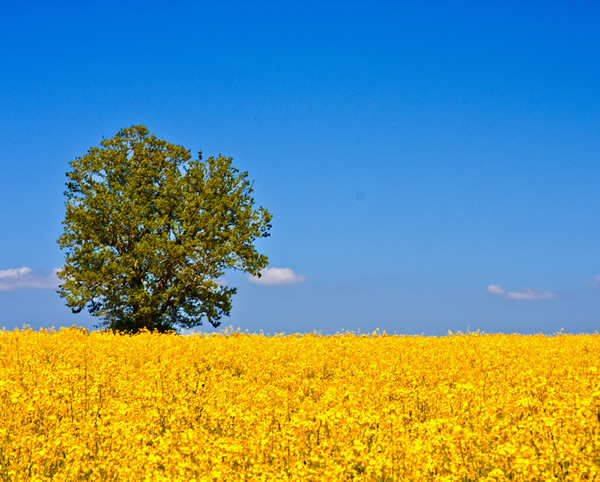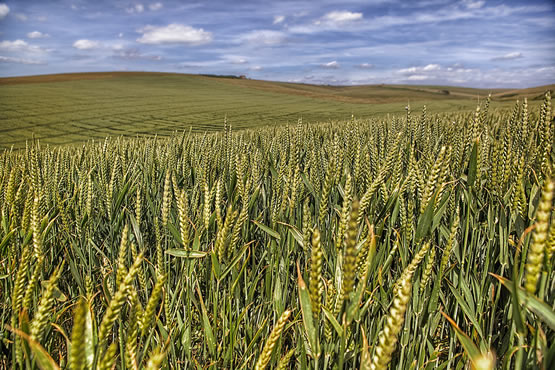 |
| Yellow rapeseed field |
European agricultural practices are affected by the policies of the European Union, in addition to global conditions which influence farming everywhere.
Agriculture in Europe goes back to classical times. The development first of the Greek city states, then of the Roman Empire, created urban centers that required substantial amounts of food to be imported from as far away as Egypt. In the year 2000 European agriculture was dominated by two major groups: the European Union (EU), with fifteen member states, and those European states outside the EU.
The EU, which began with the Common Market created by the Treaty of Rome, signed in 1957, initially comprised France, West Germany, Italy, Belgium, the Netherlands, and Luxembourg. By the year 2000 it had expanded to include Great Britain, Ireland, Denmark, Greece, Spain, Portugal, Finland, Sweden, and Austria.
  |
Land and Workers
Only 11 percent of the land in the world (slightly more than 5 million square miles) is suitable for agriculture. Among the continents, Europe has the highest percentage of land suitable for farming: 36 percent. (In North America, the comparable figure is 22 percent.) Overall, 80 percent of the land in Europe is usable in some way, either as agricultural land or as forestland.
Smaller farms are more extensive in the southern countries of the EU than in the northern countries. Some 60 percent of all farms in the EU are less than 5 hectares (12.5 acres) in size.
Many of these small farms are either part-time or subsistence farms. Farms that are more than 50 hectares in size (125 acres, a small farm by U.S. standards) constitute only 6 percent of all farms but produce most of the crops.
 |
| Land and workers |
The percentage of the labor force employed in agriculture is small where the farms are large—in Great Britain, it is a mere 2 percent. In the rest of the EU, except for some of the more recent members, such as Greece, Spain, and Portugal, the percentages are all in the single digits.
Where the farms are small, or in non-EU countries,without the EU’s agricultural policy to push production up with high prices, the percentage of the labor force employed in agriculture is much higher. In Poland, 27 percent of the labor force is employed in agriculture; in Romania, 21 percent; and in the Ukraine, 19 percent.
Crops
Europe produces about 19 percent of the world’s grains eaten by humans or livestock and almost 24 percent of the world’s coarse grains (barley, rye, oats). Most of all these grains are grown in Russia. Half the world’s potatoes are grown in Europe; the Russian Federation grows the largest share. Europe also grows half of the world’s peas,with 40 percent produced in the Russian Federation.
   |
Three quarters of the world’s sugar beets are grown in Europe, Ukraine being the largest European producer. Rapeseed production has been increasing; Germany is its largest producer in Europe, followed closely by France. European production is a bit more than 17 percent of world production.
Europe grows 20 percent of the world’s tomatoes, although the tomato is not a native European plant. Spain and Italy are the leading producers of tomatoes in Europe. Overall, Europe grows 16 percent of the world’s vegetables, with Italy being the largest European producer, closely followed by the Russian Federation and Spain.
 |
| European crop fields |
More than half of the world’s grapes are grown in Europe. These grapes feed Europe’s great wineries, which produce 70 percent of the world’s wine, a substantial proportion of which is drunk in Europe, although it remains an important export item.
Europe also produces nearly three-quarters of the world’s hops, which go into the much-prized European beers. Europe grows more than half the world’s olives, almost all of them in Italy, Spain, and Greece. These countries also produce about 60 percent of the world’s olive oil.
Agricultural Revolution
Beginning in the 1970’s, Europe underwent what has been called a new agricultural “revolution.” Ownerships were consolidated, especially in Britain but also in France and Germany. As a result, owners of the larger holdings were able to invest in modern agricultural machinery.
Now, 44 percent of the world’s tractors are owned in Europe, mostly in France, Italy, and Poland. This has helped make European agriculture so productive that, according to the U.S. Department of Agriculture, Europe’s best farms are as efficient as the best in the United States.
European farmers vastly increased their yields in the second half of the twentieth century. Britain’s wheat output is up 60 percent from what it was immediately after World War II; the growth in output is nearly as great in France.
In general, European agricultural productivity grew 5 percent a year between 1960 and 1999. Productivity grew much less in Eastern Europe than in Western Europe. This is partly because rainfall there varies so widely from year to year.
 |
| Agricultural revolution |
In 1979 the EU moved from being an importer of cereal grains to an exporter, as it did in 1975 for sugar and in 1976 for wine. Since 1960, the number of workers employed in agriculture has dropped by 50 percent, although the agricultural output remains the same or even higher.
Authorities in Britain have estimated that farms there are at their most efficient when they employ no more than two or three people—a far cry from the hundreds of people who worked Europe’s farms for subsistence wages in earlier centuries.
Irrigation and Drainage
Despite the generally favorable climate, Europe has 10 percent of the world’s irrigated acreage. Most of that is in the Russian Federation, but Italy, Spain, and Romania also have significant amounts.
A striking feature of European agriculture is the extent to which agricultural lands—some of them former wetlands—have been drained, to ensure uniform moisture for the crops being grown. In Finland, 91 percent of the agricultural land has been drained. Hungary has seen 70 percent of its land drained; the Netherlands, 65 percent; Britain, 60 percent; and Germany, 50 percent.
Environment
 |
| Grape vines |
One factor that is assuming increasing influence over European agriculture is environmental concerns. The heavy use of fertilizers, pesticides, and herbicides has created damaging environmental conditions in some countries. The amount of cow manure generated in the Netherlands by its super efficient dairy industry is more than the land of the entire country could absorb.
The Dutch government subsidizes a company that composts some of this manure and sells it abroad as fertilizer for flowers. Sweden compensates farmers who reduce the runoff from their farms, a growing problem as the nitrogen content in water rises from fertilizer run-off.
The EU has introduced a program to compensate those who set land aside for environmental protection, but more needs to be done to bring the EU’s production levels closer to domestic demand, as well as to reduce the cost to consumers and tax payers of the subsidies paid to farmers.
Organic Farming and Bioengineering
 |
| Organic Farming and Bioengineering |
Some scientists believe that environmental improvement could be generated if crops were developed that could ward off the insects that attack them, or that provide their own nitrogen, as the leguminous plants (peas and beans) do. Nevertheless, the European environmental movement has strongly opposed genetically modified foods, in part citing risks to health and the environment.